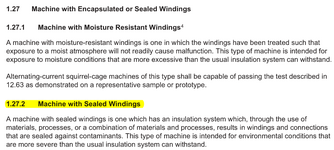Something manufactured to IEC 60034-18 with a GLOBAL VPI insulation system MAY meet the sealed winding criteria. The only way to know is to perform the sealed winding conformance test per NEMA MG 1 (2011 version) Section II Clause 12.62. (I think there is a similar method defined somewhere in the IEC world, but I cannot recall in which standard it might appear. For all I know, they might refer to the NEMA criteria.)
The bottom line is that "sealed" means the winding will not allow any moisture ingress - including through the lead cable jacket. It also means it will not allow moisture to accumulate and track along an exposed surface to any significant degree. The test method is either by complete immersion for a defined period or by a "spray" test (usually restricted to much larger geometries, such as those exceeding 2.5 at the stator inside diameter). Both methods use a wetting agent to ensure moisture "sticks" and "clings" to the winding so that it will be absorbed, if it is possible to do so.
If the machine is in critical service, the chances are excellent that as a user you would require that the specific machine being purchased pass the test - not just accept a manufacturer's statement that "... our machines generally meet the criteria and a representative example sometime a while back passed ...".


